
Wine Culture and Information since 2002 - Volume 23
 Wine Culture and Information since 2002 - Volume 23 |
|
Contrasts of Malvasia Bianca Lunga and GrecoTwo ancient grapes, used in many Italian wines, give two different ways of interpreting wine, two distinct characters in every sensorial aspect |
|
Italy is a country having a richness in wine grape varieties having no equal in no other country of the world. This richness - an incredible heritage of the Italian territory - allow every region and place to offer absolutely unique and unrepeatable wines. Many of these grapes have very ancient origins, many of them were introduced by the ancient people who lived or colonized the territory which will later become Italy. A huge viticultural and wine heritage: the Registro Nazionale delle Varietà di Vite da Vino (National Directory of Wine Grape Varieties) currently counts about five hundred different grapes, a remarkable richness having no equals. A condition which can be considered both positive and negative. This richness causes in fact a remarkable fragmentation of country's wine production without an effective cohesion of the many areas, on the contrary it is the proof of a complex, extraordinary and unique viticultural vocation. The influence of the ancient civilizations in the viticultural and wine making fate of Italy has clearly been fundamental. Not only it determined the introduction of countless wine grapes: it also contributed - in particular - to the viticultural and wine making development of many wines and areas of the past in Italy. Many of them keep their prestige still today, witnesses of a thousand years long history which reached our days, most of the times with the same glory. The two grapes of this month's tasting by contrast have ancient origins, cultivated in Italy since remote times, both having a connection with ancient Greece. Greco and Malvasia Bianca Lunga (Long White Malvasia), besides being quite common in the Italian territory, they are used for the making of many wines, both alone and used with other varieties, certainly among the most significant grapes of Italy.
|
|
Malvasia Bianca Lunga - also known as Malvasia Toscana and Malvasia del Chianti - is one of the many grapes belonging to the Malvasie family. Widely common in central Italy, Malvasia Bianca Lunga has been for a long time one of the grapes allowed for the production of Chianti according to the famous recipe of Baron Ricasoli. Characterized by a pretty long cluster - sometimes longer than twenty-five centimeters - Malvasia Bianca Lunga makes wines of medium body and light aromas. This grape is rarely used alone, however it is widely used in countless wines blended to other varieties. In particular, Malvasia Bianca Lunga is frequently used for the production of Vin Santo, always blended to other varieties typical in central Italy. Wines produced with Malvasia Bianca Lunga are characterized by a pleasing crispness, with a pretty light aromatic profile and, for this reason, they are usually used blended to other grapes instead of being used alone. The “Malvasie” family is made of a rich number of members and includes both white and red berried varieties. The origin of this grape family is Greece, in particular Nomemvasia, a village in Peloponnese, in which is found the main port where Venetian merchants were used to land. They in fact introduced this variety in the Italian territory, by adapting the name of the Greek village to a more “Italian” Malvasia. The spreading of Malvasia grapes has progressively reached all the Italian territory, islands included, and today there are many varieties belonging to this family, both white and red. When tasted, the berries of Malvasia Bianca Lunga have pleasing aromas, however its wines have a quite light aromatic profile. One of the main characteristics of wines produced with Malvasia Bianca Lunga is the pleasing crispness and sapidity, frequently used to give other wines a kind of lively character.
|
||||
|
A variety of very ancient origins, Greco is the protagonist of many famous white wines of South Italy - alone or blended to other varieties - of which the most famous one certainly is Greco di Tufo. Talking about Greco grape, we need to clear an ambiguous aspect about the name. This variety is simply called “Greco” and it should not be confused with “Greco Bianco”, another excellent variety famous for the production of the wines of Bianco, a village of Calabria. In this case, in fact, “Bianco” - white in Italian - does not refer to the color of the grape, indeed it is referred to the place of origin. Greco, despite has in Campania its best expression and notoriety, is cultivated in other regions of central-south Italy as well as and it is also found in Tuscany. Its most famous wine expression evidently is Greco di Tufo, the well known village of the Irpinia area in province of Avellino and having the Denominazione d'Origine Controllata e Garantita, DOCG appellation. A variety of evident Greek origin, this grape was introduced in the territory of Campania by Greek colonizers, probably coming from ancient Thessaly. Wines produced with Greco grape have been widely praised by the authors of the past, who appreciated both the quality of its wines and the places in which they were produced at. Greco - as well as wines of Greek origin - has been a cause of speculation and still today there is a high number of varieties which name is directly or indirectly connected to the term greco. Most of the times it is not about a direct connection to this variety - or to a grape of Greek origin - indeed it is referred to the fact their wines recall, in some aspects, the ones made in Greece, highly appreciated in the past. Greco is a grape difficult to cultivate and vinify, a characteristic determining, sometimes, the production of ordinary wines. The greatness of this variety - capable of making wines of remarkable quality - is expressed through a viticulture and wine making without compromises and no mistakes.
|
As usual, the wines of our tasting by contrast are exclusively produced with the grapes we are going to evaluate in our study. Choosing a wine produced with 100% Greco is not so difficult, whereas it will be a little harder to get a wine made with Malvasia Bianca Lunga. As for Greco, the wine we will choose is a Greco di Tufo and we will make sure it is vinified in inert containers, preferably steel tanks. As for the second wine, we will choose an Amelia Malvasia - Denominazione d'Origine Controllata of Umbria - and making sure it is a wine produced with 100% Malvasia Bianca Lunga. We should in fact consider production disciplinary of this wine allows a minimum of 85% for this variety. Also in this case, we will choose a wine fermented and aged in steel tanks in order not to affect the expression of grapes. In both cases we will choose wines belonging to the most recent vintage and served in tasting glasses at the temperature of 10 °C (50 °F). Let's start our tasting by contrast and, as usual, the first aspect we will evaluate in both wines is appearance, quality expressed by color and transparency. The first wine we will examine is Amelia Malvasia. Let's tilt the glass on a white surface and observe the base of the glass. The color of this wine reveals a pale and light greenish yellow, with a very high transparency. Nuances, observed at the edge of the liquid mass, towards the opening of the glass, reveals - also in this case - a greenish yellow color. Let's now pass to the evaluation of Greco di Tufo: the color of this wine is evidently darker and fuller, showing an intense and brilliant straw yellow hue, as well as a high transparency. Nuances confirm the color observed at the base of the glass. Let's now compare both wines: differences in color and nuances are evident. To the nose, Malvasia Bianca Lunga and Greco have remarkable differences both in terms of intensity and quality. Malvasia Bianca Lunga, despite its fresh fruits and juice are quite aromatic, makes wines with pretty pale aromas and, in certain cases, neutral as well. The profile of Greco is evidently different, giving to the nose more intense and full aromas, having a stronger personality and power. Malvasia Bianca Lunga expresses to the nose aromas of pear, melon and peach, sometimes apricot, to which follow flower aromas mainly recalling broom. Greco gives to the nose of the taster aromas recalling peach, apple and pear, as well as aromas of tropical fruits - in particular pineapple - to which follow sensations of citrus fruits, hazelnut and hawthorn. Moreover, in certain cases, both varieties can express to the nose mineral sensations, in particular Greco wines produced in Tufo, in Irpinia area. The first wine of which we will evaluate aromas is Amelia Malvasia. With the glass in vertical position and without swirling, let's proceed with the first smell allowing the evaluation of opening. We can perceive the light character, even gentle, of Malvasia, with a moderate strength however elegant and agreeable. From the glass we can perceive aromas of pear, peach and broom, of moderate intensity, however pleasing and clean. After having swirled the glass - in order to allow the development of other aromas - the profile of Malvasia Bianca Lunga is completed by melon, apple, hawthorn and apricot, sometimes pineapple. Let's now pass to the evaluation of Greco di Tufo's opening: from the glass are perceived more intense and powerful aromas than Malvasia, in which can be recognized peach, apple, pear and hawthorn. After having swirled the glass, the profile of Greco is completed by citrus fruits, plum, pineapple and the typical hint of hazelnut. Moreover, it can also be perceived hints of almond and medlar, as well as a mineral touch. Let's now compare the olfactory profiles of both glasses: differences are evident, in particular in terms of intensity. Let's now pass to the gustatory evaluation of the wines of our tasting by contrast, starting - just like the previous phases - from Amelia Malvasia. Take a sip of this wine and evaluate its attack, that is the initial sensation perceived in the mouth. Malvasia Bianca Lunga is characterized by a pleasing crispness - the effect of acidity - and a body of medium structure. In the mouth are perceived the flavors of pear, peach, apple and melon, confirming the good correspondence to the nose. Let's now evaluate the attack of Greco di Tufo: in the mouth is perceived an evident crispness and a body of good structure, clearly stronger than Malvasia Bianca Lunga. It will be perceived a good sensation of roundness - also because of the effects of alcohol - including, clean and intense, flavors of apple, pear, peach and plum. Let's now compare the two wines, in particular the differences in terms of structure and roundness: Malvasia Bianca Lunga appears to be lighter although being characterized by an elegant finesse. The last phase of our tasting by contrast will focus on the sensations the wines leave in the mouth after swallowing, in particular taste-olfactory persistence. The finish of Amelia Malvasia is characterized by a pleasing crispness and a sensation of light body, leaving in the mouth flavors of peach, apple and, sometimes, pineapple and apricot. Persistence is good, confirming the flavors and qualities perceived in the gustatory phase. The finish of Greco di Tufo has good persistence leaving in the mouth intense flavors of apple, peach and plum, as well as the typical sensation of hazelnut, sometimes almond as well. In Greco di Tufo is perceived a more robust and rounder finish, however expressing the pleasing vivacity of acidity. On this regard, the difference with Malvasia Bianca Lunga is evident and clear even in the final phase of tasting, expressing different characters however pleasing in both cases.
|
||||||||
Wines of the Month |
|
|
|
Score legend Prices are to be considered as indicative. Prices may vary according to the country or the shop where wines are bought |
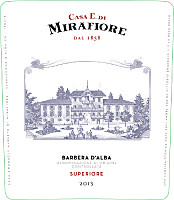
|
|
Barbera d'Alba Superiore 2013 |
|
| Mirafiore (Piedmont, Italy) | |
 Barbera Barbera | |
| Price: € 16.20 | Score: |
 Intense ruby red and nuances of ruby red, little transparency. Intense ruby red and nuances of ruby red, little transparency. Intense, clean, pleasing and refined, starts with hints of cherry, plum
and raspberry followed by aromas of violet, blackberry, blueberry, vanilla,
chocolate and menthol. Intense, clean, pleasing and refined, starts with hints of cherry, plum
and raspberry followed by aromas of violet, blackberry, blueberry, vanilla,
chocolate and menthol.
 Properly tannic attack and however balanced by alcohol, good body,
intense flavors, pleasing crispness. Properly tannic attack and however balanced by alcohol, good body,
intense flavors, pleasing crispness.
 Persistent finish with flavors of cherry, plum and raspberry. Persistent finish with flavors of cherry, plum and raspberry. 12 months in cask, 6 months in bottle. 12 months in cask, 6 months in bottle. |
|
 Stuffed pasta with mushrooms, Roasted meat, Stewed meat, Cheese Stuffed pasta with mushrooms, Roasted meat, Stewed meat, Cheese |
|
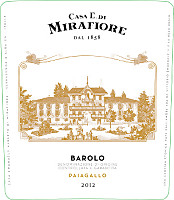
|
|
Barolo Paiagallo 2012 |
|
| Mirafiore (Piedmont, Italy) | |
 Nebbiolo Nebbiolo | |
| Price: € 45.00 | Score: |
 Brilliant ruby red and nuances of garnet red, moderate transparency. Brilliant ruby red and nuances of garnet red, moderate transparency. Intense, clean, pleasing, refined and elegant, starts with hints of
cherry, plum and violet followed by aromas of raspberry, rose, strawberry,
vanilla, tobacco, black pepper, cinnamon, cocoa, black pepper and mace. Intense, clean, pleasing, refined and elegant, starts with hints of
cherry, plum and violet followed by aromas of raspberry, rose, strawberry,
vanilla, tobacco, black pepper, cinnamon, cocoa, black pepper and mace.
 Tannic attack and however balanced by alcohol, full body, intense
flavors, pleasing crispness. Tannic attack and however balanced by alcohol, full body, intense
flavors, pleasing crispness.
 Persistent finish with flavors of cherry, plum and raspberry. Persistent finish with flavors of cherry, plum and raspberry. 24 months in cask, 12 months in bottle. 24 months in cask, 12 months in bottle. |
|
 Game, Roasted meat, Braised and stewed meat, Hard cheese Game, Roasted meat, Braised and stewed meat, Hard cheese |
|
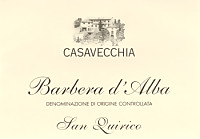
|
|
Barbera d'Alba San Quirico 2013 |
|
| Casavecchia (Piedmont, Italy) | |
 Barbera Barbera | |
| Price: € 6.80 | Score: |
 Brilliant ruby red and nuances of ruby red, little transparency. Brilliant ruby red and nuances of ruby red, little transparency. Intense, clean, pleasing and refined, starts with hints of cherry, plum
and blueberry followed by aromas of violet, blackberry, raspberry,
cyclamen, carob and vanilla. Intense, clean, pleasing and refined, starts with hints of cherry, plum
and blueberry followed by aromas of violet, blackberry, raspberry,
cyclamen, carob and vanilla.
 Properly tannic attack and however balanced by alcohol, good body,
intense flavors, pleasing crispness. Properly tannic attack and however balanced by alcohol, good body,
intense flavors, pleasing crispness.
 Persistent finish with flavors of cherry, plum and blueberry. Persistent finish with flavors of cherry, plum and blueberry. 12 months in cask, at least 6 months in bottle. 12 months in cask, at least 6 months in bottle. |
|
 Broiled meat and barbecue, Roasted meat, Stewed meat with mushrooms Broiled meat and barbecue, Roasted meat, Stewed meat with mushrooms |
|
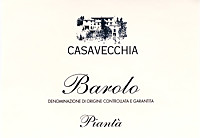
|
|
Barolo Piantà 2009 |
|
| Casavecchia (Piedmont, Italy) | |
 Nebbiolo Nebbiolo | |
| Price: € 21.50 | Score: |
 Intense ruby red and nuances of garnet red, little transparency. Intense ruby red and nuances of garnet red, little transparency. Intense, clean, pleasing, refined and elegant, starts with hints of
cherry, plum and violet followed by aromas of raspberry, blueberry,
vanilla, rose, tobacco, chocolate, mace, cinnamon, leather and menthol. Intense, clean, pleasing, refined and elegant, starts with hints of
cherry, plum and violet followed by aromas of raspberry, blueberry,
vanilla, rose, tobacco, chocolate, mace, cinnamon, leather and menthol.
 Tannic attack and however balanced by alcohol, full body, intense
flavors, pleasing crispness. Tannic attack and however balanced by alcohol, full body, intense
flavors, pleasing crispness.
 Persistent finish with flavors of cherry, plum and raspberry. Persistent finish with flavors of cherry, plum and raspberry. 2 years in cask, at least 18 months in bottle. 2 years in cask, at least 18 months in bottle. |
|
 Game, Roasted meat, Stewed and braised meat, Hard cheese Game, Roasted meat, Stewed and braised meat, Hard cheese |
|
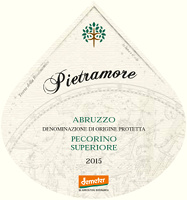
|
|
Abruzzo Pecorino Superiore 2015 |
|
| Antica Tenuta Pietramore (Abruzzo, Italy) | |
 Pecorino Pecorino | |
| Price: € 7.20 | Score: |
 Intense straw yellow and nuances of straw yellow, very transparent. Intense straw yellow and nuances of straw yellow, very transparent. Intense, clean, pleasing and refined, starts with hints of apple, plum
and peach followed by aromas of hawthorn, citrus fruits, broom and melon. Intense, clean, pleasing and refined, starts with hints of apple, plum
and peach followed by aromas of hawthorn, citrus fruits, broom and melon.
 Crisp attack and however balanced by alcohol, good body, intense
flavors, pleasing roundness. Crisp attack and however balanced by alcohol, good body, intense
flavors, pleasing roundness.
 Persistent finish with flavors of apple, plum and peach. Persistent finish with flavors of apple, plum and peach. Aged in steel tanks. Aged in steel tanks. |
|
 Pasta with meat and mushrooms, Broiled fish, Sauteed meat, Mushroom soups Pasta with meat and mushrooms, Broiled fish, Sauteed meat, Mushroom soups |
|
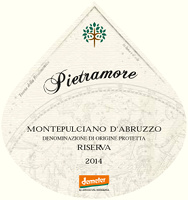
|
|
Montepulciano d'Abruzzo Riserva 2013 |
|
| Antica Tenuta Pietramore (Abruzzo, Italy) | |
 Montepulciano Montepulciano | |
| Price: € 11.20 | Score: |
 Intense ruby red and nuances of garnet red, little transparency. Intense ruby red and nuances of garnet red, little transparency. Intense, clean, pleasing and refined, starts with hints of plum, black
cherry and blackberry followed by aromas of violet, blueberry, vanilla,
raspberry, tobacco, mace and menthol. Intense, clean, pleasing and refined, starts with hints of plum, black
cherry and blackberry followed by aromas of violet, blueberry, vanilla,
raspberry, tobacco, mace and menthol.
 Properly tannic attack and however balanced by alcohol, good body,
intense flavors, pleasing roundness. Properly tannic attack and however balanced by alcohol, good body,
intense flavors, pleasing roundness.
 Persistent finish with flavors of plum, black cherry and blackberry. Persistent finish with flavors of plum, black cherry and blackberry. 6 months in steel tanks, 18 month in barrique, at least 6 months in
bottle. 6 months in steel tanks, 18 month in barrique, at least 6 months in
bottle.
|
|
 Roasted meat, Stewed meat with mushrooms, Broiled meat and barbecue, Hard cheese Roasted meat, Stewed meat with mushrooms, Broiled meat and barbecue, Hard cheese |
|
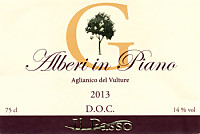
|
|
Aglianico del Vulture Alberi in Piano 2013 |
|
| Il Passo (Basilicata, Italy) | |
 Aglianico Aglianico | |
| Price: € 25.00 | Score: |
 Intense ruby red and nuances of garnet red, little transparency. Intense ruby red and nuances of garnet red, little transparency. Intense, clean, pleasing, refined and elegant, starts with hints of
black cherry, plum and blackberry followed by aromas of violet, blueberry,
juniper, vanilla, graphite, raspberry, cinnamon, chocolate, tobacco,
leather and menthol. Intense, clean, pleasing, refined and elegant, starts with hints of
black cherry, plum and blackberry followed by aromas of violet, blueberry,
juniper, vanilla, graphite, raspberry, cinnamon, chocolate, tobacco,
leather and menthol.
 Properly tannic attack and however balanced by alcohol, full body,
intense flavors, pleasing crispness and roundness. Properly tannic attack and however balanced by alcohol, full body,
intense flavors, pleasing crispness and roundness.
 Persistent finish with flavors of black cherry, plum and blackberry. Persistent finish with flavors of black cherry, plum and blackberry. 18 months in cask. 18 months in cask. |
|
 Game, Roasted meat, Stewed and braised meat with mushrooms, Hard cheese Game, Roasted meat, Stewed and braised meat with mushrooms, Hard cheese |
|
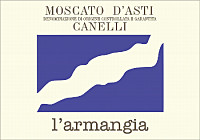
|
|
Moscato d'Asti Canelli 2016 |
|
| L'Armangia (Piedmont, Italy) | |
 Moscato Bianco Moscato Bianco | |
| Price: € 7.50 | Score: |
 Brilliant greenish yellow and nuances of greenish yellow, very
transparent. Brilliant greenish yellow and nuances of greenish yellow, very
transparent.
 Intense, clean, pleasing and refined, starts with hints of grape, peach
and banana followed by aromas of white rose, lychee, apple, pear, broom,
citrus fruits, candied fruits and sage. Intense, clean, pleasing and refined, starts with hints of grape, peach
and banana followed by aromas of white rose, lychee, apple, pear, broom,
citrus fruits, candied fruits and sage.
 Sweet and effervescent attack, however balanced, light body, intense
flavors, agreeable. Sweet and effervescent attack, however balanced, light body, intense
flavors, agreeable.
 Persistent finish with flavors of grape, apple and banana. Persistent finish with flavors of grape, apple and banana. Fermented in closed tank. Fermented in closed tank. |
|
 Cream and fruit desserts Cream and fruit desserts |
|

|
|
Barbera d'Asti Superiore Nizza Vignali 2011 |
|
| L'Armangia (Piedmont, Italy) | |
 Barbera Barbera | |
| Price: € 22.00 | Score: |
 Intense ruby red and nuances of garnet red, little transparency. Intense ruby red and nuances of garnet red, little transparency. Intense, clean, pleasing, refined and elegant, starts with hints of
cherry, plum and blueberry followed by aromas of violet, blackberry,
vanilla, raspberry, tobacco, cocoa, mace, cinnamon and menthol. Intense, clean, pleasing, refined and elegant, starts with hints of
cherry, plum and blueberry followed by aromas of violet, blackberry,
vanilla, raspberry, tobacco, cocoa, mace, cinnamon and menthol.
 Properly tannic attack and however balanced by alcohol, good body,
intense flavors, pleasing roundness. Properly tannic attack and however balanced by alcohol, good body,
intense flavors, pleasing roundness.
 Persistent finish with flavors of cherry, plum and blueberry. Persistent finish with flavors of cherry, plum and blueberry. 13 months in barrique, 12 months in cask, about 36 months in bottle. 13 months in barrique, 12 months in cask, about 36 months in bottle. |
|
 Broiled meat and barbecue, Roasted meat, Stewed and braised meat, Hard cheese Broiled meat and barbecue, Roasted meat, Stewed and braised meat, Hard cheese |
|

|
|
Barolo Bricat 2011 |
|
| Manzone Giovanni (Piedmont, Italy) | |
 Nebbiolo Nebbiolo | |
| Price: € 45.00 | Score: |
 Brilliant ruby red and nuances of garnet red, moderate transparent. Brilliant ruby red and nuances of garnet red, moderate transparent. Intense, clean, pleasing, refined and elegant, starts with hints of
cherry, plum and violet followed by aromas of raspberry, strawberry,
vanilla, rose, iris, chocolate, tobacco, cinnamon, mace, tobacco and
menthol. Intense, clean, pleasing, refined and elegant, starts with hints of
cherry, plum and violet followed by aromas of raspberry, strawberry,
vanilla, rose, iris, chocolate, tobacco, cinnamon, mace, tobacco and
menthol.
 Tannic attack and however balanced by alcohol, full body, intense
flavors, pleasing crispness and roundness. Tannic attack and however balanced by alcohol, full body, intense
flavors, pleasing crispness and roundness.
 Persistent finish with flavors of cherry, plum and raspberry. Persistent finish with flavors of cherry, plum and raspberry. 30 months in cask. 30 months in cask. |
|
 Game, Roasted meat, Stewed and braised meat, Hard cheese Game, Roasted meat, Stewed and braised meat, Hard cheese |
|

|
|
Barolo Riserva Gramolere 2009 |
|
| Manzone Giovanni (Piedmont, Italy) | |
 Nebbiolo Nebbiolo | |
| Price: € 70.00 | Score: |
 Intense ruby red and nuances of garnet red, moderate transparency. Intense ruby red and nuances of garnet red, moderate transparency. Intense, clean, pleasing, refined and elegant, starts with hints of
cherry, plum and violet followed by aromas of raspberry, blueberry,
vanilla, strawberry jam, dried rose, face powder, tobacco, cocoa, mace,
cinnamon, licorice, leather and menthol. Intense, clean, pleasing, refined and elegant, starts with hints of
cherry, plum and violet followed by aromas of raspberry, blueberry,
vanilla, strawberry jam, dried rose, face powder, tobacco, cocoa, mace,
cinnamon, licorice, leather and menthol.
 Tannic attack and however balanced by alcohol, full body, intense
flavors, pleasing crispness. Tannic attack and however balanced by alcohol, full body, intense
flavors, pleasing crispness.
 Very persistent finish with long flavors of cherry, plum and blueberry. Very persistent finish with long flavors of cherry, plum and blueberry. 48 months in cask, 12 months in bottle. 48 months in cask, 12 months in bottle. |
|
 Game, Stewed and braised meat, Roasted meat, Hard cheese Game, Stewed and braised meat, Roasted meat, Hard cheese |
|
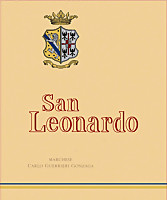
|
|
San Leonardo 2000 |
|
| Tenuta San Leonardo (Trentino, Italy) | |
 Cabernet Sauvignon (60%), Cabernet Franc (15%), Carménère (15%), Merlot (10%) Cabernet Sauvignon (60%), Cabernet Franc (15%), Carménère (15%), Merlot (10%) | |
| Price: € 85.00 | Score: |
 Intense ruby red and nuances of garnet red, little transparency. Intense ruby red and nuances of garnet red, little transparency. Intense, clean, pleasing, refined and elegant, starts with hints of
black currant, plum and dried violet followed by aromas of black cherry,
blueberry, flint, tobacco, green bell pepper, vanilla, tobacco, cigar box,
face powder, cocoa, leather, tar and eucalyptus. Intense, clean, pleasing, refined and elegant, starts with hints of
black currant, plum and dried violet followed by aromas of black cherry,
blueberry, flint, tobacco, green bell pepper, vanilla, tobacco, cigar box,
face powder, cocoa, leather, tar and eucalyptus.
 Tannic attack and however balanced by alcohol, full body, intense
flavors, pleasing crispness. Tannic attack and however balanced by alcohol, full body, intense
flavors, pleasing crispness.
 Very persistent finish with long flavors of black currant, plum and
black cherry. Very persistent finish with long flavors of black currant, plum and
black cherry.
 24 months in barrique, at least 12 months in bottle. 24 months in barrique, at least 12 months in bottle. |
|
 Game, Roasted meat, Braised and stewed meat, Hard cheese Game, Roasted meat, Braised and stewed meat, Hard cheese |
|
|
||||||||
|
DiWineTaste Polls
|
| |||||||
Privacy Policy | |||||||


| Copyright © 2002-2025 Antonello Biancalana, DiWineTaste - All rights reserved |
| All rights reserved under international copyright conventions. No part of this publication and of this WEB site may be
reproduced or utilized in any form or by any means, electronic or mechanical, without permission in writing from DiWineTaste. |